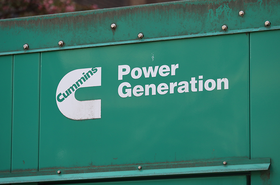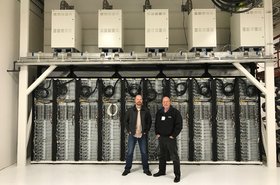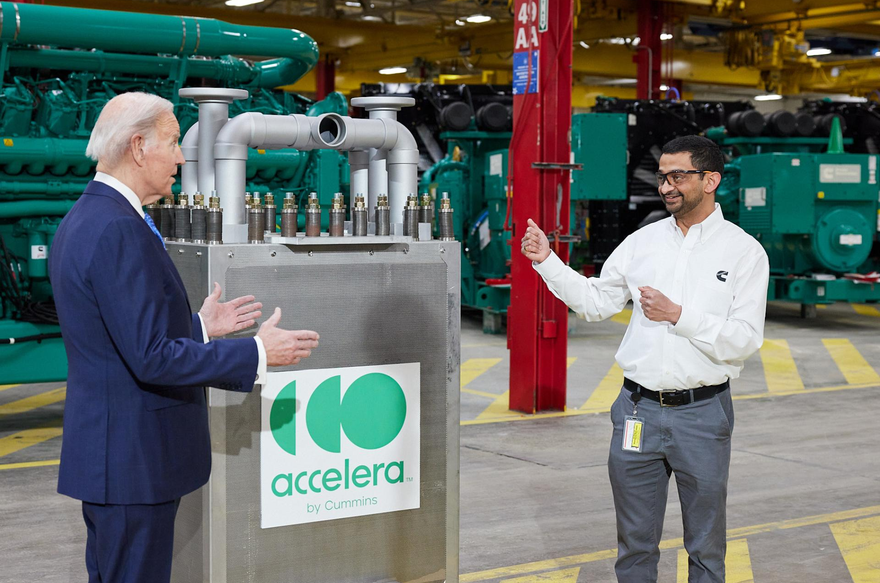Few other industries are as focused on sustainability and carbon reduction as the data center sector. That’s according to Rich Scroggins, technical advisor - data center markets, at Cummins. “‘Aggressive’ might not be quite the right word, but the focus on sustainability is a lot greater in the data center sector than most other industries. At least, that’s my perception,” says Scroggins.
It goes without saying that Cummins is most closely associated with diesel engines – not a product line with the most environmentally friendly of reputations. But there is a lot more to the company than that. Indeed, Cummins is one of a handful of industrial manufacturers that are leading the way on the decarbonization of heavy industry, arguably the economic sector most challenged by sustainability demands.
And the work that Cummins is doing to make its operations, products, and suppliers more sustainable will help organizations in many other sectors all over the world in their own sustainability programs.
“"We are being approached regarding Scope 3 emissions, which have become a big thing for our customers due to the need to track and report carbon emissions,” says Scroggins.
Scope 3 emissions are all about taking account of the carbon emissions in the supply chain and can therefore be tricky to calculate when the components of a complex product might come from every corner of the world.
Scroggins continues: “Our customers also have their ESG goals and they’re asking us for carbon assessments or life cycle carbon accounting. We’re approaching this both for our mobility markets – for vehicle engines – as well as for our data center customers.”
There are three different ways to approach these demands. A ‘carbon assessment’ entails a high-level calculation of carbon emissions in the production and operation of a product.
The lifecycle assessment, meanwhile, is a much more detailed process. “This is the next level. It looks at all phases of the product lifecycle, from mineral extraction to manufacturing and end-of-life treatment, and we collaborate with our suppliers to do that. When a supplier is unable to do that, we revert to our engineering judgment to provide a professional estimate.
“The third level is the environmental product declaration. This is where we bring-in a third-party to validate our life cycle assessments,” says Scroggins.
However, he cautions, carbon accounting is still in its infancy and is a fast-evolving discipline. “We don’t have lifecycle assessments for all of our products right now, but we’re collaborating with our customers to help them meet their sustainability goals. When you examine the carbon content of just one item of equipment, there’s a lot there.
“So we’ve started with one engine platform and are using that as a baseline for the others, but it’s a bigger challenge than it might sound, especially for a global company.”
For example, one engine platform may not just have multiple different variations, but could be built in a number of locations, using materials for the same parts from multiple different suppliers: iron mined, smelted, refined into steel and turned into components in different parts of the world by different companies will have very different carbon emission numbers attached.
Green steel and HVO
Of course, the advent of ‘green steel’ – iron smelted using hydrogen created with renewable energy, typically either wind or hydro, rather than coking coal – is on Cummins’ radar. While the carbon in coking coal drives out the oxygen in iron ore, creating carbon dioxide as a by-product, hydrogen produces just water. But to be sustainable requires hydrogen produced using renewable power.
This steel production technique has only relatively recently been perfected and procuring this ‘green steel’, when it becomes available in volume in the next few years, will mean stepping beyond the company’s first-level supplier. That is where the value of Cummins’ current drive to map out Scope 3 emissions will come into its own.
“Steel is a major component of the carbon embodied in an engine. It’s certainly something we’re looking at, but as we don’t buy raw steel, we have to go to our suppliers and encourage them,” says Scroggins. Indeed, Cummins has been encouraging suppliers to participate in the various lower-carbon industry groups.
He continues: “More broadly, in the automotive sector, there are a number of industry group initiatives, including one called ‘Steel Zero’. It’s therefore not just the data center sector that’s pushing strongly on this, but more and more automotive customers, too.”
Cummins, as a company, has its own interest in these emerging low-carbon production processes that will be central to achieving Net Zero: as an engineering company, it also designs, makes and supplies the electrolyzers that are central to the production of low-emission hydrogen – extracting it from water – and the company is making more and more investments in this area, too.
But while green steel produced from hydrogen is a few years away, there are many actions that can be taken today to improve data center sustainability.
Chief among these, believes Scroggins, is simply upgrading backup genset fuel from diesel to hydrotreated vegetable oil (HVO).
HVO is a synthetic paraffinic diesel, made from vegetable oils or waste, reprocessed with added hydrogen. Unlike previous biofuels, it is a drop-in replacement fuel that can be used without modifications to existing engines, and offers greater stability than biodiesel, due to the bio-treatment process that removes impurities and saturates the double bonds in the oil.
Of course, HVO isn’t emissions-free, but with much of the fuel derived from recycled plant matter its net CO2 emissions are considerably lower than regular diesel, with nitrogen oxide emissions estimated to be lower by about five percent, too.
“Depending on who you ask, HVO provides about a seventy percent reduction in carbon intensity compared to conventional diesel, but doesn’t reduce NOx or other ‘tail pipe’ emissions. So there's certainly still some limitations, but the massively reduced carbon emissions, coupled with after-treatment systems that can reduce NOx by as much as 99 percent, and means that you can keep the technology while still keeping to your sustainability roadmap,” says Scroggins.
Two is better than one
More exciting still, perhaps, is the possibility of running back-up power on hydrogen, especially with the discovery of naturally occurring ‘white hydrogen’ reserves in recent years. After all, hydrogen has the highest energy by mass of any fuel.
Fuel cells, meanwhile, could be going mainstream much sooner. After all, points out Scroggins, PEM fuel cells have been around since the 1960s, although never manufactured at scale. Originally developed for NASA’s Gemini space program, they were replaced by alkaline fuel cells for the Apollo space program that put the first man on the Moon.
However, the drive towards Net Zero has reinvigorated development of fuel cell technology of all types, including at companies like Cummins that are not just looking beyond fossil fuels, but how the next steps on the journey towards Net Zero can best be taken.
Indeed, Cummins is involved in the research and development of fuel cell technology via Accelera, its new power division.
“The question is how fast fuel cell technology will develop, but I think it’s in mobility markets where the scale will come in the form of smaller modules. Then you’ll see them in the data center with 3MW modules, built out from smaller modules used in automotive applications,” says Scroggins. That, he adds, is how one of the world’s biggest technology companies approached the technology with its recent fuel cell pilot project.
For mainstream data center operators, which have smaller margins than the industry giants and who will therefore be more cautious, the question of whether to adopt hydrogen engines or fuel cells will almost certainly be dictated by cost and value for money considerations, not to mention the ability to ensure that whatever technology they do adopt can keep the data center running for at least 24 hours.
“Looking at some of our projections, even if the capital expenditure of fuel cells comes down, the question is whether the Capex associated with hydrogen storage is going to come down. Keeping 24 hours of fuel on site could be both very expensive, and require a lot of space. There is also a safety concern as it is a hazardous material,” says Scroggins.
However, even these risks have already been faced in industries that use hydrogen routinely in their operations – for example, in the production of fertilizers – and thought through.
“Hydrogen is used in industrial processes and there are standards for storing and transporting hydrogen safely. But it is a hazardous material and storing it for long-term use is challenging, so we won’t want to store it on site. Instead, we can establish hydrogen hubs and pipe it in, although that will require something of a mindset change,” says Scroggins.
But quite apart from the fact that hydrogen fuel cells or engines running on hydrogen-based fuel are, perhaps, a decade or more away from mainstream adoption, there remain a number of cost and some other practical issues that have yet to be overcome.
Some work also remains on improving the levels of efficiency of hydrogen-based engine technology, which has increased markedly over the past decade, and this will only continue to improve as the current decade wears on.
To ease the transition, therefore, Scroggins believes that dual fuel engines could be the most viable next step forward: reducing the carbon emissions of existing assets by substituting hydrogen for a portion of the diesel fuel used, enabling operation on hydrogen, but minimizing hydrogen supply chain risks by maintaining the ability to revert to diesel should hydrogen fuel become unavailable.
“What I’m referring to is an engine that needs to have diesel and can have hydrogen or natural gas injected into it, so you could retain the capital investment of the diesel engines for some time to come,” he explains. This could help data center operators in markets that want to shift towards ‘green hydrogen’, but are not confident of a reliable supply, helping them make the transition.
Likewise, solid oxide fuel cells (SOFC) might make a valuable intermediate step as they can run on natural gas, with the fuel cell extracting the hydrogen from the methane gas as its source of power. Eventually, SOFC could be modified to run on hydrogen at some point in the future should pipeline H2 become commonly available, making SOFC a potential bridge technology for prime power.
The disadvantage, however, is that it can take a solid oxide fuel cell hours to step-up to full power so isn’t suitable as a source of back-up power.
In other words, the shift towards Net Zero and greater sustainability could involve big changes in the way in which data centers are powered – both in terms of primary power and back-up – with a combination of fuels and fuel cells to ensure reliable, always-on service. Moreover, it will be a lengthy process, and one that will take many years, requiring flexible diesel generators and more along the way.
To find out more about what Cummins is doing to make its business – and yours – more sustainable, how it is reducing carbon across its Scope 1, 2 and 3 emissions, and its developments in fuel cell technology go to Cummins’ dedicated data centers website
More...
-

Solving power generator problems
How Cummins sees the future of power playing out
-

DCD>Talks Onsite Power & Decarbonisation with James Wadey, Cummins
We sat down with James Wadey, director of data center strategic accounts at Cummins to discuss onsite power & decarbonisation
-

Fueling the future
We look at Microsoft, NREL and Daimler’s approaches to fuel cells in the data center



